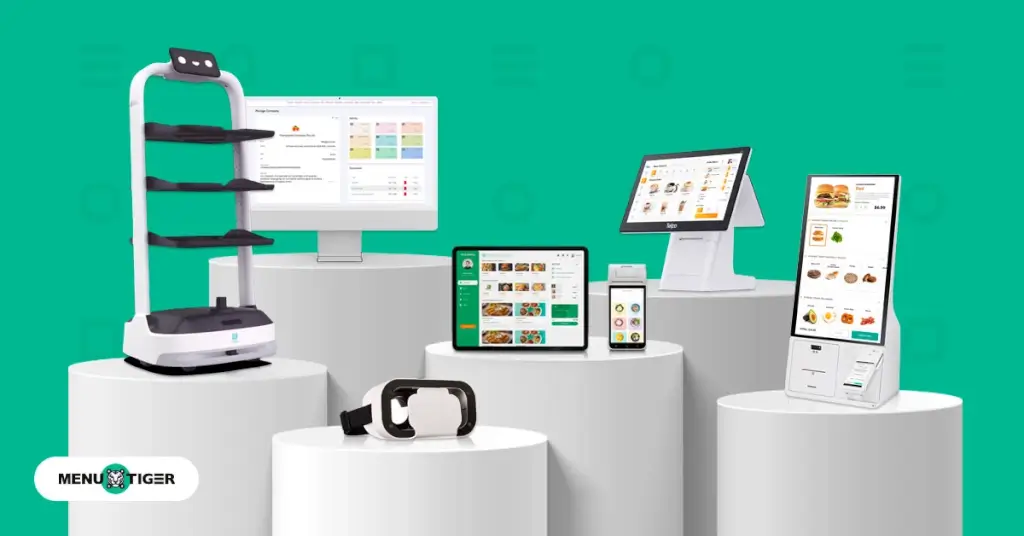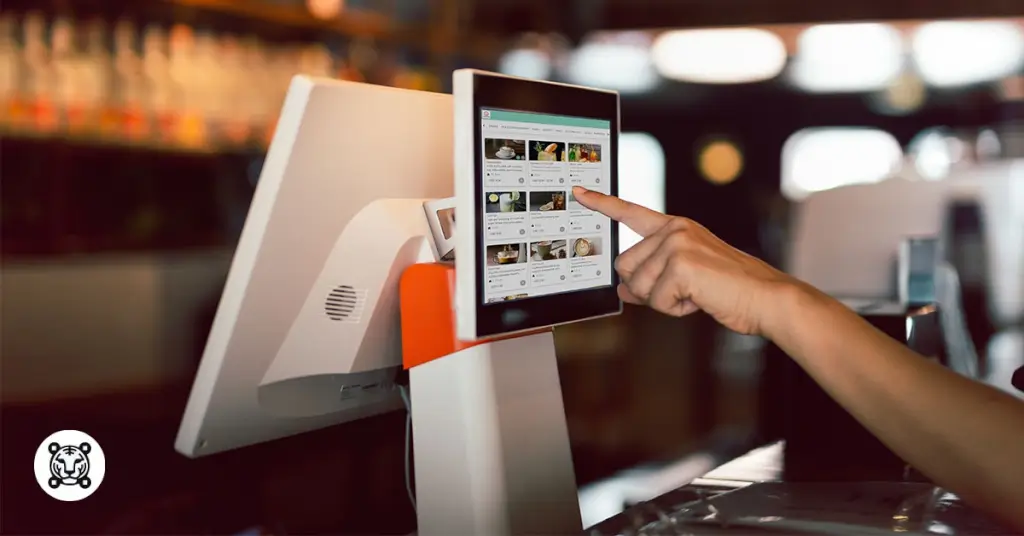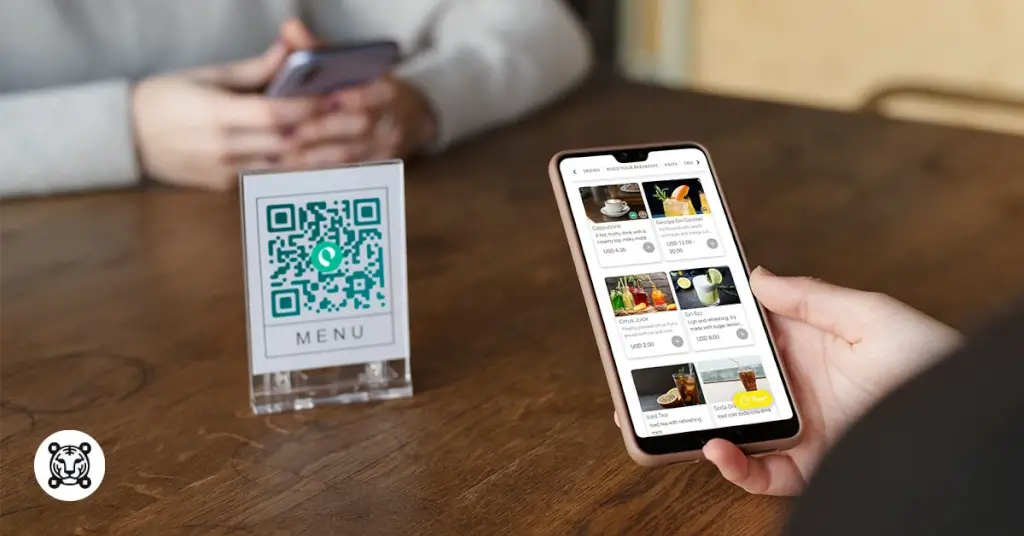
9 Advanced Restaurant Technology Trends for 2026
Last Updated: December 17, 2025
Restaurant technology trends 2026: A new wave of innovative restaurant technology trends is set to redefine how we eat out.
For you, as part of the industry that creates unforgettable dining experiences for your customers, taking note of these technology trends is crucial.
Not only does it set you apart from your competitors, but it also elevates your restaurant’s operations and services, allowing you to serve your customers at your best.
What is restaurant technology?
When we talk about restaurant technology, we’re referring to advanced and innovative tools and systems that streamline restaurant management–from taking orders and reservations to kitchen operations and customer interactions.
Essentially, it includes technological solutions that respond to your needs and improve overall operational management and efficiency.
For instance, using an online menu enhances customer interaction and engagement.
Customers can access your offerings through their smartphones and order and pay simultaneously, making the process much easier.
Why is it important to keep up with new restaurant technology trends?
Keeping up with innovative food industry technology trends is crucial to staying competitive and ahead of your game.
With the latest restaurant innovations, you can offer an advanced dining experience, streamline restaurant processes, and make data-driven decisions that position your business ahead of the curve, attracting a broader customer base and fostering long-term success.
9 food industry technology trends to watch out for

1. AI-driven dynamic menus
AI-driven dynamic menus are a great example of how new restaurant tech is reshaping the way customers interact with menus and personalize their dining experience.
Unlike other static options, this dynamic menu leverages the power of an artificial intelligence (AI) Agents, allowing it to adapt with a high level of customization in real-time.
Here’s how these work:
- Customer preferences
The system can identify your customers' preferences through learning and data-feeding. This can be done by analyzing their favorite dishes, dietary restrictions, and past order history.
- External influences
To provide accurate assistance, real-time external factors like weather conditions, local events, or even trends in social media are also considered.
- Supply chain information
Integration with the supply chain allows the system to adjust menu items based on the availability and freshness of ingredients.
- Sales data history
Sales data from past transactions provide insights into popular items during specific times, allowing for adjustments in terms of what should be highlighted or taken off the menu.
2. Robotic table service
This buzz-worthy trend can provide a futuristic dining experience for your customers by having a robot deliver their food.
This innovative approach creates a blend of technology and hospitality that revolutionizes the traditional role of your waitstaff.
Your robotic table service guarantees an efficient and accurate serving process. These robots have trays, sensors, and programmed algorithms to navigate the dining area.
These integrations ensure timely and precise serving of your customers' dishes.
3. Blockchain for supply transparency
A blockchain is a decentralized digital ledger that records transactions across multiple computers securely and transparently.
Each block in the chain has your list of transactions, and once completed, it is linked to the previous one to form a chain.
Implementing this technology in your restaurant inventory system ideally with the help of a reliable blockchain development company will help enhance transparency in your food supply.
Each participant in the supply chain, from the farmers and distributors to your kitchen, records their transactions on the blockchain, making a chronological and transparent history of products, allowing anyone with access to trace the journey of each ingredient.
With this, it would be easier to spot contaminated products before they get into your restaurant, allowing you to prevent food waste and, at the same time, create a safe dining environment.
4. Virtual and augmented reality dining experiences
Virtual Reality (VR) and Augmented Reality (AR) applications create immersive dining experiences through an interactive virtual menu, 3D visualization of dishes, and virtual cooking demonstrations.
Incorporating these technologies into your restaurant operations will set you apart in this competitive industry.
For example, you may set a corner in your restaurant where your customers can experience cooking your dishes in a simulated kitchen using a VR headset.
This can redefine how customers perceive and engage with food, turning a simple meal into an extraordinary journey for the senses.
5. Voice-activated ordering and assistance
Having voice-activated ordering and assistance represents a transformative shift in how customers interact with your restaurant. Think of a restaurant phone system, but better.
The seamless integration of voice commands into your customers' dining experience allows them to redefine convenience, accessibility, and personalization.
Here’s how it works:
Voice recognition technology
The voice-activated systems rely on advanced voice recognition technology that interprets spoken language and converts it into actionable commands.
A notable example is Amazon’s Alexa, which, by leveraging an AI voice generator, builds natural voice experiences, offering customers an intuitive way of interacting with technology.
You can ask questions or give commands, and it responds using the data it can access.
Natural Language Processing (NLP)
NLP algorithms enable understanding and responding to natural language queries, allowing for more conversational interactions.
With this, your customers can place orders hands-free, simplifying the process, especially when using a device might be impractical.
Another notable benefit of using it is that it caters to a broader audience, including those with visual or motor impairments, making the ordering process more inclusive.
6. Contactless digital payments with digital menu QR codes
Integrating contactless technologies like QR codes into digital payments in restaurants has become a game-changer for this industry.
From seamless transactions to enhanced hygiene practices, these technologies transform how customers interact with and pay for their meals.
Using a digital menu QR code for cashless payment transactions allows customers to access your menu by scanning the QR code with their smartphones, making it hassle-free because they don’t need to wait in line at the counter.
Another good thing about this technology is that it can show additional taxes on your prices. This way, when customers order and pay, they would not be surprised by the bills.
This establishes trust and transparency in your restaurant, which helps boost your branding.
In addition to QR code and digital payment options, many restaurants are embracing flexible payment collection with Pay by Link, which lets customers pay securely through channels like SMS or email—no website or terminal needed.
It’s a convenient, secure option for takeout, delivery, and event catering.
Note: Add instructions on how to scan a menu QR code for your customers to be guided, especially those who are elderly.
7. Biometric identification for personalization
Biometric identification, using unique physical characteristics for personal recognition, is now finding innovative applications in the restaurant industry.
Here’s how biometrics shape the future of personalized restaurant service:
- Customized menus: You can use biometric data based on individual preferences, dietary restrictions, and past order history.
- Preferred seating and ambiance: Biometrics can be used to identify preferred seating arrangements or lighting preferences, allowing you to tailor your environment to individual tastes.
- Automated ordering: Your regular customers can benefit from this based on their preferences. Using biometric identification, it would be easier for them to personalize their orders.
- Enhanced loyalty programs: You can take advantage of biometrics in your loyalty programs, allowing customers to seamlessly earn and redeem rewards without needing physical cards or identification.
- Targeted promotions: Using biometric data, you can tailor promotional offers and discounts based on customer profiles and spending behaviors. This ensures the effectiveness of your promotional strategies and eventually helps boost sales.
8. Cloud kitchens
The rise of cloud kitchens, often called ghost kitchens, alters the traditional restaurant landscape.
These establishments operate solely for delivery and takeout, eliminating the need for dine-in spaces.
An example of this is the CloudKitchens Company, established in 2015, which offers food preparation facilities for food delivery-only services.
Because the transactions are purely virtual, it has lower overhead costs than physical outlets.
However, it still focuses on providing efficient operations by leveraging technology to optimize order processing to ensure swift deliveries and maintain the quality of service.
9. 5G-powered smart restaurant
An innovative dining establishment leverages the capabilities of fifth-generation (5G) mobile networks to revolutionize various aspects of restaurant operations and services.
It provides seamless connectivity and efficient operations. It enhances customer engagement by integrating technologies to create a more interactive, personalized, and efficient dining environment.
If you’re considering exploring this improvement, you might want to start integrating Internet of Things (IoT) devices like smart kitchen appliances equipped with sensors and temperature controls.
Using this will help you manage food storage, prolonging the shelf-life of your produce, especially those perishable ingredients.
Aside from managing food storage, it also functions as a restaurant inventory system, allowing you to track supply levels, set expiration dates, and monitor temperature to ensure ingredient freshness and reduce food waste.

What are the impacts of technology on the restaurant business?
Before upgrading your restaurant with these restaurant technology trends, you need to know what contributions they can make to boost your business.
We’ve listed these contributions to help you assess whether these trends are worth trying.
Streamlined restaurant operations using interactive restaurant menu software
If you are going to upscale your operations from the kitchen to your customers’ table, having advanced technology like interactive menu software is undoubtedly a must.
You don’t need to worry about unattended orders, supply inventory mishaps, or manual errors, as you can manage it all in one software.
Enhanced customer experience
Restaurant technologies aim to improve the overall dining environment for customers to enjoy.
These offer conveniences like online reservations, contactless payments, and personalized recommendations without the hassle of fumbling through layers of paper or waiting in line at the counter.
Data-driven decision-making through restaurant technologies
Adopting technology allows you to collect and analyze data related to customer preferences, order history, restaurant marketing statistics, and operational performance.
Modern restaurants are increasingly relying on data analysis to determine customer preferences and optimize their operations.
Understanding statistical programming languages is crucial in this tech-driven landscape. These insights provide factual information that enables informed decision-making, helping you tailor your offerings and strategies to meet customer demands.
Those interested in enhancing their restaurant analytics can look into courses like the introduction to R by DataCamp, designed for mastering data manipulation and creating insightful analyses that drive decision-making in businesses.
Whether it is your food or services, having this data will be helpful to meet the needs of your business.
Adaptation to marketing trends
In business, setting yourself apart from a very competitive industry means you need to build your image and branding.
You may go for a vintage vibe or minimalist restaurant themes to adapt to the changing market trends and consumer preferences.
By staying in the loop on what’s new, whether incorporating new ingredients, offering innovative menu items, or adopting the latest culinary techniques, technology facilitates agility in response to industry dynamics.
Online ordering growth with QR code menu

In a recent report about customer service by SuperOffice, a Customer Relationship Management (CRM) system builder, 86% of buyers are willing to spend more for a great customer experience.
In the restaurant industry, providing customers with the best and most seamless order process is a plus for your business.
So, choosing the best QR code menu for restaurants fuels the growth of a seamless ordering service.
You can reach a broader audience and generate revenue by putting your code on your social media accounts, flyers, or paper bags. These are just a few QR code menu ideas you can try.
Also, your customers do not have to wait for their orders to be taken as soon as they enter your restaurant; they can order at their convenience.
Supply Chain Transparency and sustainability
Transparency and sustainability are two crucial aspects of modern business practices, especially in this industry, which relies on complex and global supply chains.
Having tools highlighting these two is spot-on and enhances the trust among your customers and investors.
It helps identify and mitigate risks, ensures compliance with regulations, and supports ethical and responsible operations.
Aside from that, it is sustainable as it involves integrating environmentally and socially responsible practices into all stages of the supply chain, from sourcing raw materials to product disposal.
Contactless dining experience with QR code menu
In response to the global pandemic, it is evident that technology has changed the game in implementing contactless dining options.
Contactless digital menus accessed via QR codes, along with contactless payment systems and mobile ordering apps, minimize physical touchpoints, contribute to improved hygiene practices, and ensure customer safety.
MENU TIGER: Keeping up with restaurant trends with an interactive menu software

Keeping up with constant changes in restaurant technology trends might be costly if you're still starting.
But it does not mean you won’t be able to stay in the loop. You just need the right technology that responds to the needs of your restaurant.
If you're looking for a technology that can help you streamline your operations, upscale your restaurant services, and boost sales through marketing campaigns, MENU TIGER is the right one for you.
This interactive menu software can:
Produce an interactive and engaging online menu
With its highly customizable options, you can design your menu with high-resolution images and vivid descriptions.
Give personalized options for customers
Your customers can tailor their orders according to their dietary restrictions and preferences.
Provide insightful data
Track your sales, orders, customers, and most sold food items with sales and revenue reports to help you make data-driven decisions.
Create attractive QR code menus
You can generate and customize QR codes according to your restaurant’s branding, creating a solid and stable identity.
Boost sales with email marketing campaigns
You can send out your campaigns, including promotions and special deals, to your loyal patrons via automated emails.

Wrapping up
Staying ahead of your game is one thing you should focus on, especially in this competitive business industry you’re in.
If you’re just starting, you might get overwhelmed by your investment, but it doesn’t have to be that way–having the right tool could help you get there.
With MENU TIGER, you’re in the right hands. Because it's an all-around software, it can respond directly to the primary needs of your restaurant to level up your customer satisfaction.
Find out more about this innovative and smart technology.
Go to the website, create an account, and let’s revolutionize your customers’ dining experience.
FAQs
Chevy
Before joining MENU TIGER's Content Team, Chevy has been dabbling in literary arts for five years, specifically creative writing in a theatre company. She loves exploring her creativity through painting, photography, and contemporary dancing.


